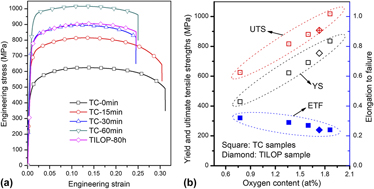Crossref Citations
This article has been cited by the following publications. This list is generated based on data provided by
Crossref.
Chen, Aijun
Deng, Hao
Chen, Longqing
Wei, Yongqiang
Xia, Zuxi
and
Tang, Jun
2018.
Structure and Mechanical Properties of Low Doped‐Zr TC4 Alloy Prepared by Spark Plasma Sintering.
Advanced Engineering Materials,
Vol. 20,
Issue. 12,
FUKUO, Mizuki
KARIYA, Shota
UMEDA, Junko
KONDOH, Katsuyoshi
and
YOSHIYA, Masato
2018.
Strengthening Mechanisms of Powder Metallurgy Extruded CP Titanium Materials with Zirconium and Oxygen Solid Solution via Decomposition of ZrO<sub>2</sub> Additives in Sintering.
Journal of the Japan Society of Powder and Powder Metallurgy,
Vol. 65,
Issue. 12,
p.
746.
Shen, J.
Chen, B.
Umeda, J.
and
Kondoh, K.
2018.
Advanced Mechanical Properties of a Powder Metallurgy Ti-Al-N Alloy Doped with Ultrahigh Nitrogen Concentration.
JOM,
Vol. 70,
Issue. 5,
p.
626.
Wang, D.W.
Zhou, Y.H.
Shen, J.
Liu, Y.
Li, D.F.
Zhou, Q.
Sha, G.
Xu, P.
Ebel, T.
and
Yan, M.
2019.
Selective laser melting under the reactive atmosphere: A convenient and efficient approach to fabricate ultrahigh strength commercially pure titanium without sacrificing ductility.
Materials Science and Engineering: A,
Vol. 762,
Issue. ,
p.
138078.
Zhang, Lin
2019.
Studying Stability of Atom Packing for Ti Nanoparticles on Heating by Molecular Dynamics Simulations.
Advanced Engineering Materials,
Vol. 21,
Issue. 4,
Shen, Jianghua
Chen, Biao
Umeda, Junko
Zhang, Jiong
Li, Yulong
and
Kondoh, Katsuyoshi
2019.
Rate sensitivity and work-hardening behavior of an advanced Ti-Al-N alloy under uniaxial tensile loading.
Materials Science and Engineering: A,
Vol. 744,
Issue. ,
p.
630.
Fukuo, Mizuki
Kariya, Shota
Umeda, Junko
Kondoh, Katsuyoshi
and
Yoshiya, Masato
2019.
Strengthening Mechanisms of Powder Metallurgy Extruded CP Titanium Materials with Zirconium and Oxygen Solid Solution via Decomposition of ZrO<sub>2</sub> Additives in Sintering.
MATERIALS TRANSACTIONS,
Vol. 60,
Issue. 9,
p.
1881.
Katsuyoshi, Kondoh
Ryuho, Ikemasu
Junko, Umeda
Shota, Kariya
and
Khantachawana, Anak
2019.
Microstructural and mechanical properties of α-titanium sintered material via thermal decomposition of additive chromium oxide particles.
Materials Science and Engineering: A,
Vol. 739,
Issue. ,
p.
491.
Zhang, Lin
2019.
Atomic simulations of packing patterns and thermal behavior in Ti clusters.
Progress in Natural Science: Materials International,
Vol. 29,
Issue. 2,
p.
237.
Luo, Shudong
Song, Tingting
Liu, Bing
Tian, Jie
and
Qian, Ma
2019.
Recent Advances in the Design and Fabrication of Strong and Ductile (Tensile) Titanium Metal Matrix Composites.
Advanced Engineering Materials,
Vol. 21,
Issue. 7,
Zhang, Lin
and
Wang, Yaming
2019.
Packing Changes in Melting, Freezing, and Coalescence of Titanium Nanoparticles from Atomic Simulations.
JOM,
Vol. 71,
Issue. 12,
p.
4917.
Luo, Huiwen
Wu, Yulu
Diao, Xiaoou
Shi, Wendi
Feng, Fan
Qian, Fei
Umeda, Junko
Kondoh, Katsuyoshi
Xin, Haitao
and
Shen, Jianghua
2020.
Mechanical properties and biocompatibility of titanium with a high oxygen concentration for dental implants.
Materials Science and Engineering: C,
Vol. 117,
Issue. ,
p.
111306.
Kondoh, Katsuyoshi
Ichikawa, Eri
Issariyapat, Ammarueda
Shitara, Kazuki
Umeda, Junko
Chen, Biao
and
Li, Shufeng
2020.
Tensile property enhancement by oxygen solutes in selectively laser melted titanium materials fabricated from pre-mixed pure Ti and TiO2 powder.
Materials Science and Engineering: A,
Vol. 795,
Issue. ,
p.
139983.
Luo, S.D.
Song, T.
Lu, S.L.
Liu, B.
Tian, J.
and
Qian, M.
2020.
High oxygen-content titanium and titanium alloys made from powder.
Journal of Alloys and Compounds,
Vol. 836,
Issue. ,
p.
155526.
Umeda, Junko
Ishizaka, Hiroki
Li, Shufeng
Alhazaa, Abdulaziz
and
Kondoh, Katsuyoshi
2020.
Comparison study on mechanical properties of powder metallurgy titanium materials with nitrogen solutes and TiN dispersoids.
Journal of Alloys and Compounds,
Vol. 846,
Issue. ,
p.
156455.
Shen, Jianghua
Chen, Biao
Umeda, Junko
Zhang, Jiong
Li, Yulong
and
Kondoh, Katsuyoshi
2020.
An in-situ study on deformation and cracking initiation in oxygen-doped commercial purity titanium.
Mechanics of Materials,
Vol. 148,
Issue. ,
p.
103519.
Issariyapat, Ammarueda
Visuttipitukul, Patama
Song, Tingting
Umeda, Junko
Qian, Ma
and
Kondoh, Katsuyoshi
2020.
Strength-ductility improvement of extruded Ti-(N) materials using pure Ti powder with high nitrogen solution.
Materials Science and Engineering: A,
Vol. 779,
Issue. ,
p.
139136.
Zhou, Yang
Yang, Fang
Chen, Cunguang
Shao, Yanru
Lu, Boxin
Lu, Tianxing
Sui, Yanli
and
Guo, Zhimeng
2021.
Mechanical property enhancement of high-plasticity powder metallurgy titanium with a high oxygen concentration.
Journal of Alloys and Compounds,
Vol. 885,
Issue. ,
p.
161006.
Cai, Zeyun
Chen, Jiayin
Du, Peng
Xiang, Tao
Chen, Jie
and
Xie, Guoqiang
2021.
Mechanical behavior and microstructure control of the low-cost titanium-oxygen alloy prepared by ball milling and spark plasma sintering.
Journal of Alloys and Compounds,
Vol. 887,
Issue. ,
p.
161349.
Kondoh, Katsuyoshi
Fukuo, Mizuki
Kariya, Shota
Shitara, Kazuki
Li, Shufeng
Alhazaa, Abdulaziz
and
Umeda, Junko
2021.
Quantitative strengthening evaluation of powder metallurgy Ti–Zr binary alloys with high strength and ductility.
Journal of Alloys and Compounds,
Vol. 852,
Issue. ,
p.
156954.




